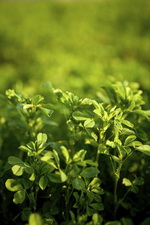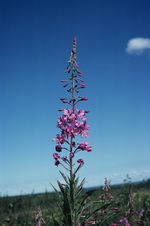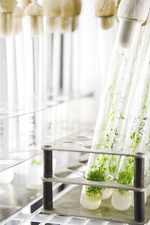CROP BIOTECH UPDATE
---------------------------------------------------------------------------
A weekly summary of world developments in agri-biotech for developing countries, produced by the Global Knowledge Center on Crop Biotechnology, International Service for the Acquisition of Agri-biotech Applications SEAsiaCenter (ISAAA)
---------------------------------------------------------------------------
December 9, 2015
In This Week’s Issue:
News
Global
• PNAS: To Feed the World in 2050 will Require a Global Revolution
Americas
• USDA Issues Preliminary Extended Determination of Nonregulated Status for V11 Potatoes
• Scientists Review ODM as Precision Genome Editing Technology
• USDA Extends Deregulation to GE Corn MZHG0JG
• Peptide Holds Promise for Increasing Crop Yields without More Fertilizer
Asia and the Pacific
• Arcadia Biosciences and BGI to Create Rice Genetics Resource
• Chemicals Helping Plants Defend Themselves Could Replace Pesticides
Europe
• Increased CO2 Altered Photosynthesis Over the 20th Century
• Swedish Board of Ag: CRISPR-Cas9 Doesn't Fall Under EU GM Definition
Research
• Scientists Investigate Metabolic Changes in GE Maize Over-expressing the Aspergillus niger phyA2
• Overexpression of the MYB37 Enhances Both Drought Tolerance and Seed Productivity in Arabidopsis
• Downregulation of Cytokinin Oxidase 2 Increases Tiller Number and Improves Rice Yield
Beyond Crop Biotech
• GM Mice Reveals Secret to Painless Existence
• SINE Compounds Inhibit Expression of XPO-1 and Shows Antitumor Properties in Prostate Cancer Models
Announcements
• Cell Culture World Congress 2016
----
NEWS
----
Global
PNAS: TO FEED THE WORLD IN 2050 WILL REQUIRE A GLOBAL REVOLUTION
Paul Ehrlich of Stanford University and John Harte of University of California wrote an opinion article in PNAS stating that a global revolution is needed to feed the world in 2050.
The authors identified different policies that could be implemented as solution to the growing population and food insufficiency. These include expansion of research on better cropping systems with long-term sustainability; increase funding and reduce impediments to promote health, education, and human rights of women; and transition to a new economic system that focuses on central issues.
Read the paper in PNAS.
Americas
USDA ISSUES PRELIMINARY EXTENDED DETERMINATION OF NONREGULATED STATUS FOR V11 POTATOES
The USDA Animal and Plant Health Inspection Service (USDA APHIS) granted the request of JR Simplot Company to extend the determination of non-regulated status of V11 Snowden Potatoes. The GE potato has low acrylamide potential and reduced black spot traits. Plant pest similarity assessment of APHIS showed that V11 potatoes are unlikely to pose plant pest risk and thus, should no longer be regulated. APHIS also prepared an Environmental Assessment and reached a Finding of No Significant Impact (FONSI).
"V11 potatoes will have no significant impacts, individually or collectively, on the quality of the human environment and will have no effect on federally listed threatened or endangered species, species proposed for listing, or their designated or proposed critical habitats," according to the APHIS document.
Read more information from APHIS.
SCIENTISTS REVIEW ODM AS PRECISION GENOME EDITING TECHNOLOGY
In an article published in Plant Biotechnology Journal, the new genome-editing technique called oligonucleotide-directed mutagenesis (ODM) was presented and reviewed as an option to accelerate development of important traits in plants. According to the paper, oligonucleotides can be used to make targeted edits in plasmid, episomal, and chromosomal DNA of bacterial, fungal, mammalian and plant systems. ODM is one of the many tools of Cibus' Rapid Trait Development System (RTDS™) technology, which offers a rapid, precise and non-transgenic breeding alternative for trait improvement in agriculture to address the urgent need to accelerate the development of these traits in plants and increase global agricultural productivity.
Read the review article from Plant Biotechnology Journal and the press release from Cibus for more information.
USDA EXTENDS DEREGULATION TO GE CORN MZHG0JG
The USDA Animal and Plant Health Inspection Service (USDA APHIS) announced the extension of deregulation of herbicide tolerant corn MZHG0JG developed by Syngenta. The same GE trait has been previously reviewed and deregulated in other GE corn plants. Based on environment assessments conducted by APHIS, it was found that the HT corn does not pose risks. The results were posted under public review from October to November 2015. On December 2, 2015, APHIS announced that the determination of nonregulatory status of the HT corn is the "most scientifically sound and appropriate regulatory decision."
Read more from APHIS.
PEPTIDE HOLDS PROMISE FOR INCREASING CROP YIELDS WITHOUT MORE FERTILIZER
 Molecular biologists from the University of Massachusetts Amherst (UMassAmherst) have discovered a "double agent" peptide in an alfalfa that promises to improve crop yields without increasing fertilizer use. The UMassAmherst team together with colleagues from the Noble Foundation, report that alfalfa appears to use an advanced process for putting nitrogen-fixing bacteria, rhizobia, to work more effectively after they are recruited from soil to fix nitrogen in special nodules on plant roots.
Molecular biologists from the University of Massachusetts Amherst (UMassAmherst) have discovered a "double agent" peptide in an alfalfa that promises to improve crop yields without increasing fertilizer use. The UMassAmherst team together with colleagues from the Noble Foundation, report that alfalfa appears to use an advanced process for putting nitrogen-fixing bacteria, rhizobia, to work more effectively after they are recruited from soil to fix nitrogen in special nodules on plant roots.
In alfalfa, the transformation of bacteria is called differentiation. NCR peptides found exclusively in the nodule, act on the bacteria in the differentiation process. The researchers discovered that one of these peptides, DNF4, also known as NCR211, supports nitrogen-fixing bacteria when inside the plant, and block free-living bacteria outside. The dual effect of DNF4/NCR211 may reflect a mechanism to ensure that the rhizobia stay in a properly differentiated state.
According to Dong Wang, professor of biochemistry and molecular biology at UM Amherst, discovering NCR211 peptides that maintain bacterial survival inside host cells may turn out to be a key factor in future efforts to improve legume crops without using more fertilizer, an important development for farming in developing countries.
For more information, read the news release from UMassAmherst.
Asia and the Pacific
ARCADIA BIOSCIENCES AND BGI TO CREATE RICE GENETICS RESOURCE
Arcadia Biosciences has formed a collaboration with BGI to create a rice genetic resource library to advance food crop research and development. BGI and Arcadia will create, sequence and characterize millions of new gene alleles to advance rice breeding globally, focusing on 5,000 proprietary indica-type rice lines from Arcadia, and featuring high-density variation within the rice genome.
BGI will determine the genomic DNA sequences for all 5,000 lines, and make the assembled and analyzed data freely available online. BGI will also store the rice seeds and distribute the lines to researchers through its China National Gene Bank in exchange for users' study results on the lines available to the public. Arcadia will maintain the rights to any findings arising from the collaboration for use in its rice R&D programs, which include developing traits for nitrogen use efficiency and salinity tolerance.
For more details, read the news release from BGI.
CHEMICALS HELPING PLANTS DEFEND THEMSELVES COULD REPLACE PESTICIDES
A new research published in Bioorganic and Medicinal Chemistry Letters has identified five chemicals that trigger the defense mechanism of rice plants to ward off the white-backed planthopper, a common rice pest.
Plants have natural self-defense mechanisms that can be switched on using chemicals that are not harmful to the environment, and are not toxic to insects or their natural enemies. In the study, researchers from Zhejiang University in China used a specially designed screening system to determine the different chemicals that switched on the plants' defense mechanism. The team designed and synthesized 29 phenoxyalkanoic acid derivatives, and identified five that could be effective at triggering the rice plants to defend themselves.
"We demonstrate for the first time that some phenoxyalkanoic acid derivatives have the potential to become such plant protection agents against the rice white-backed planthopper," said Dr. Yonggen Lou, one of the authors of the study and professor at Zhejiang University.
For more, read the Alpha Galileo news release.
Europe
INCREASED CO2 ALTERED PHOTOSYNTHESIS OVER THE 20TH CENTURY
 Researchers at Umeå University and the Swedish University of Agricultural Sciences have discovered that increasing levels of carbon dioxide in the atmosphere have shifted photosynthetic metabolism in plants over the 20th century. The first study worldwide, it deduced biochemical regulation of plant metabolism from historical specimens.
Researchers at Umeå University and the Swedish University of Agricultural Sciences have discovered that increasing levels of carbon dioxide in the atmosphere have shifted photosynthetic metabolism in plants over the 20th century. The first study worldwide, it deduced biochemical regulation of plant metabolism from historical specimens.
By monitoring plant metabolism retrospectively using historic plant samples, this research group has quantified how much increased atmospheric CO2 levels during the 20th century have contributed to plants' ability to capture the greenhouse gas carbon dioxide. They also observed shifted photosynthetic metabolism in both wild plant species as well as crops.
The study analyzed different C3 plants, and calories for human nutrition. In sugar beet samples that grew at different times between 1890 and 2012. The researchers observed a change in metabolic fluxes, which can fully be explained as CO2-driven shift, without a noticeable influence of cultivars, changes in agricultural practices or by plant breeding.
For more information, read the news release from Umeå University.
SWEDISH BOARD OF AG: CRISPR-CAS9 DOESN'T FALL UNDER EU GM DEFINITION
 CRISPR-Cas9 is a novel technique that allows scientists to make small changes in the genetic material of an organism to occur naturally and precisely. It has a wide potential for use in plant science and breeding. According to the Swedish Board of Agriculture, plants that have been transformed using this new technique do not fall under the GMO definition of the European Union. Thus, the plants can be cultivated without restriction. Countries outside EU like Argentina have announced that similarly edited plants are not covered by their GMO legislation. EU is yet to issue a decision about the matter.
CRISPR-Cas9 is a novel technique that allows scientists to make small changes in the genetic material of an organism to occur naturally and precisely. It has a wide potential for use in plant science and breeding. According to the Swedish Board of Agriculture, plants that have been transformed using this new technique do not fall under the GMO definition of the European Union. Thus, the plants can be cultivated without restriction. Countries outside EU like Argentina have announced that similarly edited plants are not covered by their GMO legislation. EU is yet to issue a decision about the matter.
Read more details from Umeå Plant Science Centre.
Research
SCIENTISTS INVESTIGATE METABOLIC CHANGES IN GE MAIZE OVER-EXPRESSING THE ASPERGILLUS NIGER PHYA2
In a study published in Plant Cell Reports, scientists compared the metabolic changes in GE maize mature seeds over-expressing the Aspergillus niger phyA2 with its non-GE counterpart and other 14 conventional maize lines to investigate substantial equivalence of the crops. Results showed that only 9 out of the 210 metabolites were significantly changed in GE maize as compared with its non-GE counterpart, and the number of significantly altered metabolites was decreased to four when the natural variations were considered. Thus, the researchers concluded that only when natural metabolic variation was taken into account, could non-targeted metabolomics provide reliable objective compositional substantial equivalence analysis on GE crops.
Read the full paper in Plant Cell Reports.
OVEREXPRESSION OF THE MYB37 ENHANCES BOTH DROUGHT TOLERANCE AND SEED PRODUCTIVITY IN ARABIDOPSIS
Although a lot of genes have been revealed to participate in abscisic acid (ABA) signaling, many of the additional components involved in ABA signaling remain to be discovered. The team of Yong-Tao Yu from Tsinghua University reports that overexpression of MYB37, aR2R3 MYB subgroup 14 transcription factor in Arabidopsis thaliana, confers hypersensitive phenotypes to ABA in all the major ABA responses.
Interestingly, MYB37-overexpression improves plant tolerance to drought, enhances growth of mature plants and seed productivity as well as delays flowering, which suggests that this gene may be used for improving crop adaptability to drought environment and productivity. These findings suggest that the MYB37 transcription factor plays an important, positive role in plant response to ABA and drought stress, and also plays a positive role in the regulation of seed production.
For more information, read the full article in Plant Molecular Biology.
DOWNREGULATION OF CYTOKININ OXIDASE 2 INCREASES TILLER NUMBER AND IMPROVES RICE YIELD
Cytokinins are hormones that affect plant growth and development. The level of cytokinins in plant cells is regulated in part through cytokinin oxidase/dehydrogenase (CKX). Among them, CKX2 has been implicated in regulation of rice grain yield.
To downregulate
OsCKX2 expression, the team led by Su-Ying Yeh of Academia Sinica in Taiwan chose two conserved glycosylation regions of
OsCKX2 for designing artificial short hairpin RNA interference
genes (shRNA-
CX3 and -
CX5, representing the 5′and 3′ glycosylation region sequences, respectively) for transformation by the
Agrobacterium-mediated method. For each construct, five transgenic rice lines with reduced
CKX2 expression were developed.
Transgenic plants in the greenhouse were greener and more vigorous with delayed senescence, compared to the wild type. In field experiments, both sets of transgenic rice plants produced more tillers and grains per plant and had a heavier 1000 grain weight than the wild type. The increases in grain yield were highly correlated with increased tiller numbers.
These results demonstrate that specific suppression of OsCKX2 expression through shRNA-mediated gene silencing leads to enhanced growth and productivity in rice by increasing tiller number and grain weight.
For more information, read the full article in
Rice.
Beyond Crop Biotech
GM MICE REVEALS SECRET TO PAINLESS EXISTENCE
People born with a rare mutation are unable to feel pain, but attempts to recreate this effect with drugs have been unsuccessful. Using mice genetically modified to carry the same mutation, researchers from University College London have now discovered the key for painlessness. It was shown in 2006 that sodium channel Nav1.7 is particularly important for signalling in pain pathways and people born with non-functioning Nav1.7 do not feel pain.
The researchers gave naloxone, an opioid blocker, to mice lacking Nav1.7, and found that they were able to feel pain. They then gave naloxone to a 39-year-old woman with the rare mutation and she felt pain for the first time in her life. Senior author Prof. John Wood said, "After a decade of rather disappointing drug trials, we now have confirmation that Nav1.7 really is a key element in human pain."
For more, read the news release from University College London.
SINE COMPOUNDS INHIBIT EXPRESSION OF XPO-1 AND SHOWS ANTITUMOR PROPERTIES IN PROSTATE CANCER MODELS
Increased expression of Chromosome Region Maintenance(CRM-1)/exportin-1 (XPO-1) has been correlated with poor prognosis in aggressive tumors, making it an interesting therapeutic target. Selective Inhibitor of Nuclear Export (SINE) compounds bind to XPO-1 and block its ability to export cargo proteins. The team led by Giovanni Luca Gravina of the University of L'Aquila in Italy investigated the effects of a new class of SINE compounds in models of prostate cancer.
The team evaluated the expression of XPO-1 in human prostate cancer tissues and cell lines. Then, six different SINE compounds were tested on prostate cancer cells representing distinct progression states and genotypes. Among the six, two SINE candidates for clinical trials, KPT-251 and KPT-330, were then tested in three cell models of aggressive prostate cancer engrafted in male mice.
XPO-1 was found to be overexpressed in prostate cancer compared to normal tissues. SINE compounds inhibited proliferation and promoted apoptosis of the tumor cells,but did not affect non-tumor prostate epithelial cells. Oral administration of KPT-251 and KPT-330 in tumor-bearing nude mice reduced tumor cell proliferation, angiogenesis and induced apoptosis.
For more information, read the article in
BMC Cancer.
Announcements
CELL CULTURE WORLD CONGRESS 2016
What: Cell Culture World Congress 2016
Where: Sofitel Munich Bayerpost, Munich
When: February 23-24, 2016
For more details, visit the Congress website.
(c) 2024. ISAAA.
 Molecular biologists from the University of Massachusetts Amherst (UMassAmherst) have discovered a "double agent" peptide in an alfalfa that promises to improve crop yields without increasing fertilizer use. The UMassAmherst team together with colleagues from the Noble Foundation, report that alfalfa appears to use an advanced process for putting nitrogen-fixing bacteria, rhizobia, to work more effectively after they are recruited from soil to fix nitrogen in special nodules on plant roots.
Molecular biologists from the University of Massachusetts Amherst (UMassAmherst) have discovered a "double agent" peptide in an alfalfa that promises to improve crop yields without increasing fertilizer use. The UMassAmherst team together with colleagues from the Noble Foundation, report that alfalfa appears to use an advanced process for putting nitrogen-fixing bacteria, rhizobia, to work more effectively after they are recruited from soil to fix nitrogen in special nodules on plant roots.  Researchers at Umeå University and the Swedish University of Agricultural Sciences have discovered that increasing levels of carbon dioxide in the atmosphere have shifted photosynthetic metabolism in plants over the 20th century. The first study worldwide, it deduced biochemical regulation of plant metabolism from historical specimens.
Researchers at Umeå University and the Swedish University of Agricultural Sciences have discovered that increasing levels of carbon dioxide in the atmosphere have shifted photosynthetic metabolism in plants over the 20th century. The first study worldwide, it deduced biochemical regulation of plant metabolism from historical specimens.  CRISPR-Cas9 is a novel technique that allows scientists to make small changes in the
CRISPR-Cas9 is a novel technique that allows scientists to make small changes in the